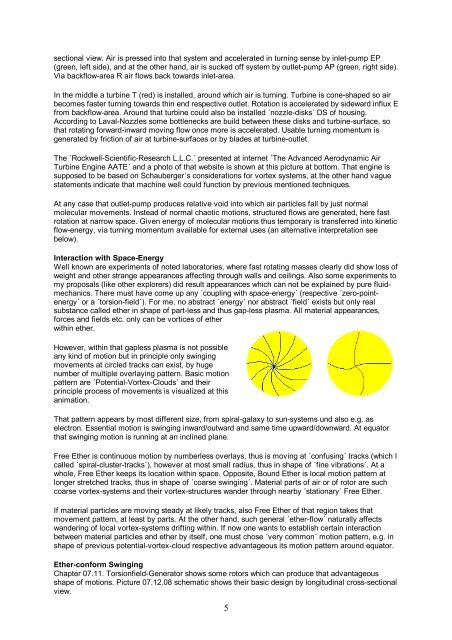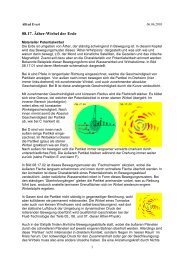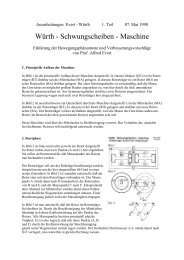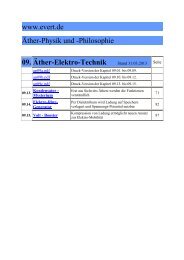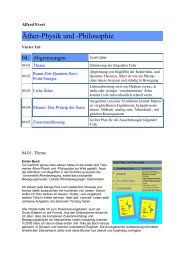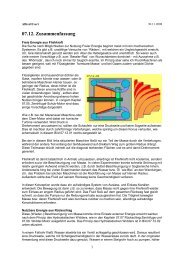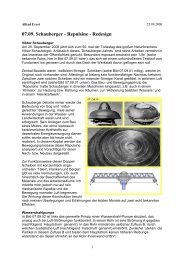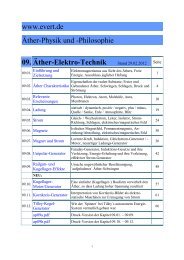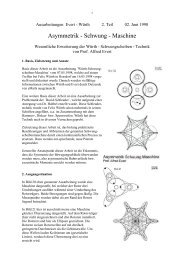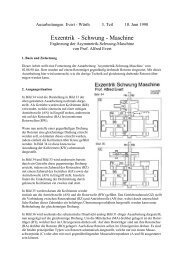Create successful ePaper yourself
Turn your PDF publications into a flip-book with our unique Google optimized e-Paper software.
sectional view. Air is pressed into that system and accelerated in turning sense by inlet-pump EP<br />
(green, left side), and at the other hand, air is sucked off system by outlet-pump AP (green, right side).<br />
Via backflow-area R air flows back towards inlet-area.<br />
In the middle a turbine T (red) is installed, around which air is turning. Turbine is cone-shaped so air<br />
becomes faster turning towards thin end respective outlet. Rotation is accelerated by sideward influx E<br />
from backflow-area. Around that turbine could also be installed ´nozzle-disks´ DS of housing.<br />
According to Laval-Nozzles some bottlenecks are build between these disks and turbine-surface, so<br />
that rotating forward-inward moving flow once more is accelerated. Usable turning momentum is<br />
generated by friction of air at turbine-surfaces or by blades at turbine-outlet.<br />
The ´Rockwell-Scientific-Research L.L.C.´ presented at internet ´The Advanced Aerodynamic Air<br />
Turbine Engine AATE´ and a photo of that website is shown at this picture at bottom. That engine is<br />
supposed to be based on Schauberger´s considerations for vortex systems, at the other hand vague<br />
statements indicate that machine well could function by previous mentioned techniques.<br />
At any case that outlet-pump produces relative void into which air particles fall by just normal<br />
molecular movements. Instead of normal chaotic motions, structured flows are generated, here fast<br />
rotation at narrow space. Given energy of molecular motions thus temporary is transferred into kinetic<br />
flow-energy, via turning momentum available for external uses (an alternative interpretation see<br />
below).<br />
Interaction with Space-Energy<br />
Well known are experiments of noted laboratories, where fast rotating masses clearly did show loss of<br />
weight and other strange appearances affecting through walls and ceilings. Also some experiments to<br />
my proposals (like other explorers) did result appearances which can not be explained by pure fluidmechanics.<br />
There must have come up any ´coupling with space-energy´ (respective ´zero-pointenergy´<br />
or a ´torsion-field´). For me, no abstract ´energy´ nor abstract ´field´ exists but only real<br />
substance called ether in shape of part-less and thus gap-less plasma. All material appearances,<br />
forces and fields etc. only can be vortices of ether<br />
within ether.<br />
However, within that gapless plasma is not possible<br />
any kind of motion but in principle only swinging<br />
movements at circled tracks can exist, by huge<br />
number of multiple overlaying pattern. Basic motion<br />
pattern are ´Potential-Vortex-Clouds´ and their<br />
principle process of movements is visualized at this<br />
animation.<br />
That pattern appears by most different size, from spiral-galaxy to sun-systems und also e.g. as<br />
electron. Essential motion is swinging inward/outward and same time upward/downward. At equator<br />
that swinging motion is running at an inclined plane.<br />
Free Ether is continuous motion by numberless overlays, thus is moving at ´confusing´ tracks (which I<br />
called ´spiral-cluster-tracks´), however at most small radius, thus in shape of ´fine vibrations´. At a<br />
whole, Free Ether keeps its location within space. Opposite, Bound Ether is local motion pattern at<br />
longer stretched tracks, thus in shape of ´coarse swinging´. Material parts of air or of rotor are such<br />
coarse vortex-systems and their vortex-structures wander through nearby ´stationary´ Free Ether.<br />
If material particles are moving steady at likely tracks, also Free Ether of that region takes that<br />
movement pattern, at least by parts. At the other hand, such general ´ether-flow´ naturally affects<br />
wandering of local vortex-systems drifting within. If now one wants to establish certain interaction<br />
between material particles and ether by itself, one must chose ´very common´ motion pattern, e.g. in<br />
shape of previous potential-vortex-cloud respective advantageous its motion pattern around equator.<br />
Ether-conform Swinging<br />
Chapter 07.11. Torsionfield-Generator shows some rotors which can produce that advantageous<br />
shape of motions. Picture <strong>07.12.</strong>08 schematic shows their basic design by longitudinal cross-sectional<br />
view.<br />
5


